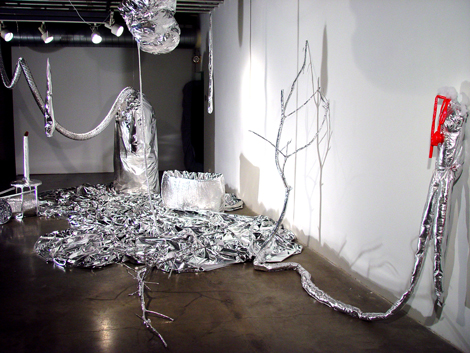After I received my MFA in the early ’90s, this country was in the midst of a serious economic downturn and alternative gallery spaces were beginning to crop up here and there. They opened in garages, storefronts and artists’ homes. They were places where artists could showcase their art even when no one was buying. Viewed as an alternative to the diminishing commercial gallery scene, in hindsight it seemed like they were fueled by the overarching need for artists to show their art and talk about it, with or without a functioning art market.
Ken Riddle, who is now the art teacher at The Waverly School, ran Bliss in Pasadena from 1987 to 1996, and Max Presneill—currently the director and curator of the Torrance Art Museum—started RAID Projects in Santa Ana in 1998; and in 1997, I set up the Brewery Project in downtown LA. Recently I checked in with Riddle and Presneill to discuss the history of our spaces and what we perceive as their successes and shortcomings.
Riddle stated that his motivation for setting up Bliss in his craftsman-style bungalow home on North Michigan Avenue and partnering with fellow students on shows was “about community, getting out and continuing with our art, presenting what we were working on in our art studies.” What really surprised him about the success of Bliss was “the amount of people who would come out to see the shows, show their appreciation for the art and even get an understanding of the setting for art in Pasadena.” Though Riddle added that there were some disagreements with artists (often fellow students) about what they thought exhibiting meant and what his role was—whether he was supposed to be a dealer or somebody who could find collectors for them.
For me, the worst part of running the Brewery Project was being among the first people that had to deal with artists as they experienced the difficulties of changing roles and mindsets; they could oscillate wildly between responsible empowerment and infantile relapses; and I was not particularly fond of the after-midnight phone calls and long messages left on my answering machine.
RAID Projects was an exhibition and curatorial organization originally founded in 1998 by Presneill in Santa Ana. RAID moved to LA later, where it hosted projects of its own, as well as for spaces in the U.S. and globally. Presneill explained, “It was about having alternatives to the few commercial galleries around and, even more importantly, bringing an international perspective to LA.” He elaborated, “Many artists I met became long-term friends. I am still working with quite a few; we travel to see each other, to talk about art and then exhibit it.” Presneill’s caveats were pretty much the same as Riddle’s and mine: the hassles that come with dealing with entitled artists. Presneill added, “Like they felt it was your responsibility to get them success, instead of treating you like a partner and peer.” In retrospect, however, all of us felt the process and duration of running an exhibition space had more positive outcomes than negative ones.
Our consensus was that the term “alternative spaces” was never really accurate since most of these places never became any real alternative to the market. Artwork hardly sold, and the alternative gallery model didn’t propose any new or specific business ideas. These exhibitions were undoubtedly better than not having any exhibition opportunities at all, but they took on many different forms in their expression of specific needs. They were not the least bit homogeneous and, moreover, didn’t actually have any discernible patterns of evolution. Episodic, occurring and recurring whenever there was a perceived abundance of artists and a lack of exhibition opportunities, these ad hoc venues would crop up and quickly disappear when a downturn occurred, morph into a traditional commercial enterprise when possible or at other times simply vanish. There is no sense of any current projects that are historically connected to the anti-materialistic ideological constructs of the 1960s.
We all agreed that we should probably understand those occurrences as something interesting and significant, and accord them value for being a slice of the larger spectrum. It was June Wayne who said that we need to explore the entire ecology of the art world, not just propagate the ideas we like most. Now that would be a meaningful evolution.






